Autumn has arrived in North Carolina, bringing with it the final harvest of bell peppers, roma tomatoes and serrano peppers.The herb garden has brushed off the first few light freezes and stands ready to make meals fragrant and savory for months to come. I am confident that the thyme, oregano and sage will over winter well and hope that the french tarragon and parsley will also.Parsley is such a staple of fall and winter dishes that I have more growing on my deck. I have been poaching from the deck parsley for a few weeks thinking that it would not handle the frosts as well, but so far it is also doing wonderfully.In previous years I have repeatedly removed pine needles from the garden beds only to replace it with a different mulch. This year I have come to my senses and am embracing the pine trees taking care of mulching for me.Collards, carrots, cabbage and parsnips are tucked into their naturally (and effortlessly) mulched beds.The fall planting of sugar snap peas has been supplying tender pea shoots and now has peas forming as well.The hydroponic herbs were changed over 10 days ago to the varieties I know and love to cook with and are already doing quite well. I am growing 2 plantings each of my favorite basils and cilantros, 3 of the flat leaf parsley and just for fun I am trying to grow 2 red kales hydroponically.With the Super Bowl and attendant tomato starts almost 2 months away, this cozy, fall garden that is mostly taking care of itself feels like a recess.
Read MoreCollards - From Garden to Table
This year I grew the heirloom collards called Georgia Southern Creole, a pre-1880 southern variety that has done quite well overall.Growing organically means that some of the leaves were ventilated by a mid-summer cross-striped cabbage worm invasion (treated with BT) and that I am currently trying to diminish the whitefly population with a hose and organic soap. Having no pests is not an option, keeping them in check is the goal.No matter how your collards were grown, its always best to give them a good soak and cleaning before cooking and the easiest way to do that is to fill up a sink with enough water to cover then swish, swirl and agitate, drain and repeat.I have tried a number of collards recipes and variations since moving to the south 3 years ago and this is the one I like best so far:Braised Collards:
1 lb of washed collards, stems still on
1 TBS oil (I use an extra virgin olive that is good for cooking, but any vegetable oil should work)
3 slices of thick sliced bacon, cut into lardons
1/2 tsp red pepper flakes (more or less depending on preference)
1 medium onion, chopped
1 TBS red wine vinegar
6 TBS stock (chicken, vegetable or mushroom)
Salt to season
Remove stems from collards and stack leaves and stems separately. Finely dice the stems and set aside. Stack a few collard leaves and roll into a cigar shape and cut crosswise (chiffonade) into 3/4" pieces, repeat until all leaves are cut and set aside separate from the stems.In a large frying pan (I like to use my 10" straight walled pan) on medium-high, heat oil until hot but not smoking. Add bacon and red pepper flakes and stir until bacon begins to crisp. Add onion and diced collard stems. Cook until onions are translucent and stems have begun to soften, about 10 minutes.Add the chopped leaves one handful at a time, turning into the bacon and onion mixture after each handful before adding the next. When all of the collards have been added and turned into the mixture, salt to season. When the mixture begins to sizzle, add the red wine vinegar and use a wooden spoon to gently deglaze the pan while turning the mixture.Add your stock* and turn into mixture, cover and turn heat to low. Let cook another 10-15 minutes until greens reach desired softness. If necessary, add more stock to keep from drying out.*Note - I filter and freeze the water after I have rehydrated morels and use this to add liquid and a delicious umame component to many dishes, including this one.
Read MoreChicago City Farm - Field Trip
I arrived in Chicago yesterday for an annual conference with a few hours to spare so I took the opportunity to go see City Farm in person! I have been looking forward to seeing this fantastic piece of urban farming/city renewal since I wrote about it in January, unfortunately the three days I am here are the three days they are closed to the public. Undeterred, I figured i could at least view it from the outside and see how the new location at W Division Street is coming along.The very warm, but tired Farm Director, Meredith, saw me taking pictures and came out to chat with me. Despite being at the farm since 5 am picking produce for the Farmer's Market, she gave me a micro-tour and we chatted about growing food.The lot looks even bigger in person and wraps north and east sides of the Chicago Fire Department building - the brick building to the right.It could not have been a more beautiful day to visit.Meredith was very excited about the tractor that will help the workers and volunteers accomplish more on this sprawling lot.It is wonderful to see young people engaging in a type of agriculture that doesn't just build farms, it builds communities. If you are ever in Chicago, preferably Wednesday-Saturday make this a must-visit!
Read MoreImma Be - Black Eyed Peas In the Garden
So maybe the July garden isn't classically beautiful, but it does have a quirky beauty...While bolted lettuce is a tall, straggly creature on its own, the Tom Thumb lettuce is also a bit elegant against the backdrop of collards:The glass gem corn is doing incredibly well (note, strawberry popcorn is not nearly so prolific):The blueberries are abundant this year:The figs, while still green, are also abundant this year:The asparagus is still throwing up occasional spears:And the tomatoes...all those tomatoes!But the star of the late July garden for me is my first ever harvest of California Black Eyed Peas! These cowpeas were planted to fix nitrogen for the corn they are growing next to and up, but now that I am seeing the beginning of what looks to be a good harvest I am excited about them for their own sake:
Read MoreFinally Spring - Garden Update
The average last frost date for this area has come and gone and the lowest nighttime temp forecast through the end of the month is 41. I think spring is finally here to stay!The French Breakfast Radishes are speeding toward their 25 days to maturity and the Lollo De Vino Lettuce is by far, the prettiest lettuce I have ever grown. The strawberries are already thickly covered in blooms and green berries.
The strawberries are already thickly covered in blooms and green berries.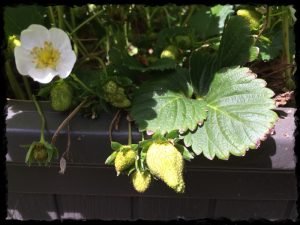 And speaking of "thick", the June-bearing variety I have put out an outrageous number of runners. I tried to stay on top of it last year, giving away dozens of rooted starts and adding many more to the compost bin, but they still managed to do a little guerrilla gardening of their own, sneaking out some late season runners to plant offspring around the designated 4'x8' beds.
And speaking of "thick", the June-bearing variety I have put out an outrageous number of runners. I tried to stay on top of it last year, giving away dozens of rooted starts and adding many more to the compost bin, but they still managed to do a little guerrilla gardening of their own, sneaking out some late season runners to plant offspring around the designated 4'x8' beds.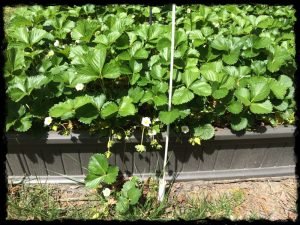 The blueberry bushes are also covered in unripe berries and continuing to bloom. This is their second summer in place and I am hoping the January pruning results in even larger, more plentiful berries than last year.
The blueberry bushes are also covered in unripe berries and continuing to bloom. This is their second summer in place and I am hoping the January pruning results in even larger, more plentiful berries than last year.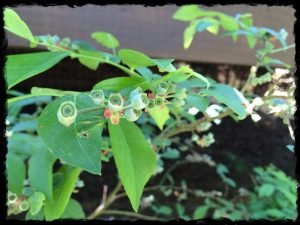 I am growing 2 varieties of Sugar Snap Peas this year, finishing out the last of my Sugar Anns and also growing a variety call simply Sugar Snap.
I am growing 2 varieties of Sugar Snap Peas this year, finishing out the last of my Sugar Anns and also growing a variety call simply Sugar Snap.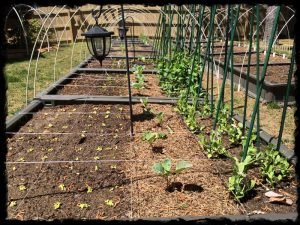 The collards and lettuces in the garden are off to a slow start which I attribute to the mostly cooler weather we have had this spring. With daytime highs starting to reach into the high 70s and low to mid 80s, I think their growth rate will pick up quickly in the next few weeks.And last, but never least, the tomatoes.
The collards and lettuces in the garden are off to a slow start which I attribute to the mostly cooler weather we have had this spring. With daytime highs starting to reach into the high 70s and low to mid 80s, I think their growth rate will pick up quickly in the next few weeks.And last, but never least, the tomatoes.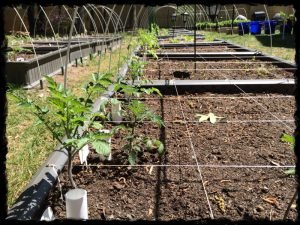 Of the 38 tomatoes that were emancipated at the end of March, I have 37 that are doing very well. The septoria leaf spot has dramatically slowed in it's progression since they were moved outside and the one Rebekah Allen tomato plant that was lost to a nighttime nibbler, has been reseeded indoors and will be replaced outdoors in a month or so.This weekend I will be sowing more herbs in the front and reseeding some of the spinach that has had less than stellar germination rates this year."In the spring, at the end of the day, you should smell like dirt." ~ Margaret Atwood
Of the 38 tomatoes that were emancipated at the end of March, I have 37 that are doing very well. The septoria leaf spot has dramatically slowed in it's progression since they were moved outside and the one Rebekah Allen tomato plant that was lost to a nighttime nibbler, has been reseeded indoors and will be replaced outdoors in a month or so.This weekend I will be sowing more herbs in the front and reseeding some of the spinach that has had less than stellar germination rates this year."In the spring, at the end of the day, you should smell like dirt." ~ Margaret Atwood
Making Lemonade
Unless I take the time to carefully pluck them out, one by one, before taking a garden pic, you have probably noticed the indecent number of pine needles lurking in the background of EVERY PHOTO I TAKE!Once upon a time I had big dreams of chicken wire leaf bins in my backyard to effortlessly convert the sweet gumball and maple leaves raked up each fall into garden gold over the course of a year. In these fantasies I would empty the bins the following fall and add the compost to my garden before starting the cycle over again.Instead, the home I purchased has pine trees. Loblolly Pine trees (Pinus taeda) to be exact and the leaves they shed do not turn into lovely compost over the course of a year but instead, remain defiantly pine needle-like for much, much longer.After a bit of debate and confirming that pine needles making soil acidic is actually an old wives tale, I decided to compost them anyway (note: this was my idea, not the pine needles').Then, magically, after two years of composting, I have...pine needles!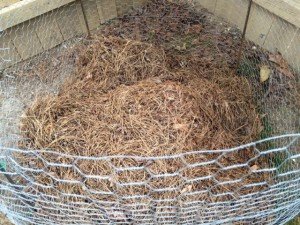 Pine needles don't turn into compost very quickly, but one of my goals this year is to mulch and I have been casting around for a sustainable, organic mulch that would work well in my garden beds. After two years of composting, I did get somewhat broken down needles that would work very well as a mulch.
Pine needles don't turn into compost very quickly, but one of my goals this year is to mulch and I have been casting around for a sustainable, organic mulch that would work well in my garden beds. After two years of composting, I did get somewhat broken down needles that would work very well as a mulch.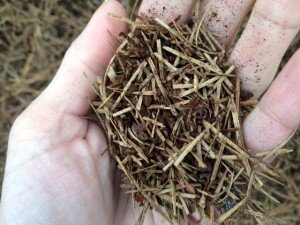 I started mulching around my transplanted collards while I wait for my direct sown spinach and sugar snap peas to fully sprout and I have to admit the result is quite nice.
I started mulching around my transplanted collards while I wait for my direct sown spinach and sugar snap peas to fully sprout and I have to admit the result is quite nice.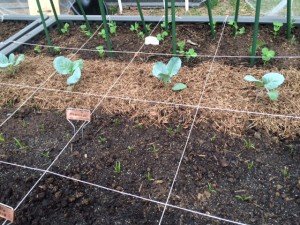 Because I have been turning the needles in their bin throughout the year, I know they hold moisture and attract earthworms so should work well as a mulch.
Because I have been turning the needles in their bin throughout the year, I know they hold moisture and attract earthworms so should work well as a mulch.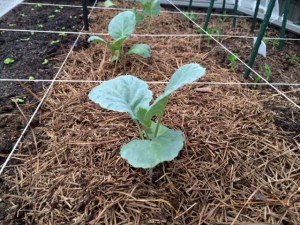 Okay, that was a completely gratuitous pic just because they looked so pretty.So now, I have made lemonade from my lemons and looking over my garden plan now I find myself in the position I could not have conceived of a year ago, I am not sure I have enough pine needles!
Okay, that was a completely gratuitous pic just because they looked so pretty.So now, I have made lemonade from my lemons and looking over my garden plan now I find myself in the position I could not have conceived of a year ago, I am not sure I have enough pine needles!
Springing Ahead
After a week of travel, timezone jet lag and leaping ahead an hour, I returned home to find my spring garden well underway.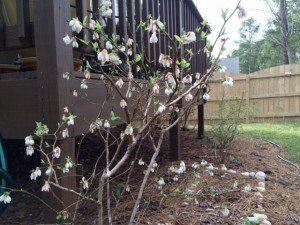 The blueberries and strawberries are already in bloom and hoping the 33 degree overnight currently forecast for Monday night doesn't damage them.
The blueberries and strawberries are already in bloom and hoping the 33 degree overnight currently forecast for Monday night doesn't damage them.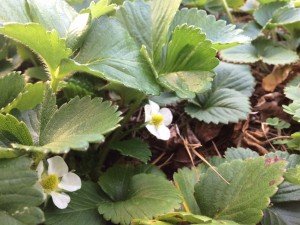 The collards, cabbage and kale have been hardened off and were transplanted yesterday near the sprouting spinach, pak choy, lettuce and sugar snap peas.
The collards, cabbage and kale have been hardened off and were transplanted yesterday near the sprouting spinach, pak choy, lettuce and sugar snap peas.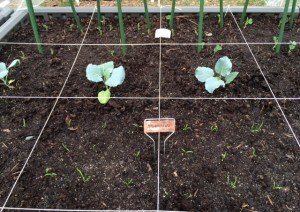 The 8 spears of asparagus that have been harvested so far have been well worth the 1 year wait and I hope some crowns that have not yet produced will begin to send up spears soon. In the meantime, I am becoming an expert on making a little asparagus go a long way in dishes.
The 8 spears of asparagus that have been harvested so far have been well worth the 1 year wait and I hope some crowns that have not yet produced will begin to send up spears soon. In the meantime, I am becoming an expert on making a little asparagus go a long way in dishes.
Then There Was One
This morning I did my final pass thinning the tomatoes, peppers, collards, cabbage and kale down to a single plant in each starter cup and then I crossed my fingers that no fungi or pests find my singletons between now and when they move outside.For now the 38 tomato plants are vigorous and hale and I am excited that fully half of them are from my own saved seed.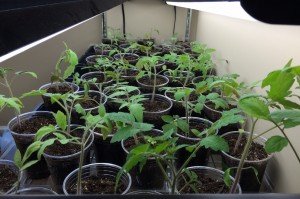 I added a few new varieties this year of both slicing and cherry tomatoes and plan to save seed from all I want to grow again next year.The cabbage and collards are nearly ready to be hardened off and will join the lettuce, spinach and leeks I will be direct sowing this weekend.
I added a few new varieties this year of both slicing and cherry tomatoes and plan to save seed from all I want to grow again next year.The cabbage and collards are nearly ready to be hardened off and will join the lettuce, spinach and leeks I will be direct sowing this weekend.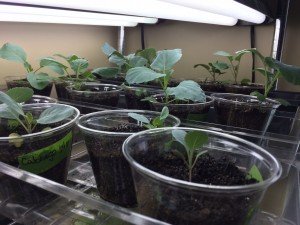 Now that the 2 week forecast has no nighttime temps below freezing it is time to get the spring garden into full swing!
Now that the 2 week forecast has no nighttime temps below freezing it is time to get the spring garden into full swing!
Tender Beginnings
While winter is having it's (hopefully) last hurrah outside, I am prepping my indoor garden to be without me for a week while I travel for work.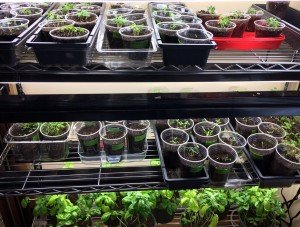 After trying first newspaper pots then peat pots for last year's starts and having them disintegrate before I was ready to transplant to the garden, this year I am using Siloé Oliveira's technique of drilling holes in smooth plastic cups that can be reused year after year.All of my starts are doing well but the ones I am happiest about are my saved seed from the Paste and Amana tomatoes I grew last year. They sprouted a few days behind the new varieties I purchased seed for this year, but since I did not ferment the saved seed I knew they would lag a bit.
After trying first newspaper pots then peat pots for last year's starts and having them disintegrate before I was ready to transplant to the garden, this year I am using Siloé Oliveira's technique of drilling holes in smooth plastic cups that can be reused year after year.All of my starts are doing well but the ones I am happiest about are my saved seed from the Paste and Amana tomatoes I grew last year. They sprouted a few days behind the new varieties I purchased seed for this year, but since I did not ferment the saved seed I knew they would lag a bit.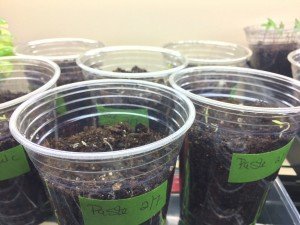 And gratuitous pics of some of the collards and other tomato varieties starts just because they are so pretty...
And gratuitous pics of some of the collards and other tomato varieties starts just because they are so pretty...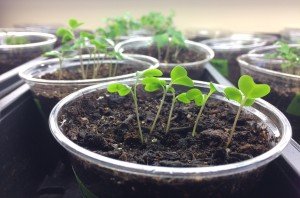
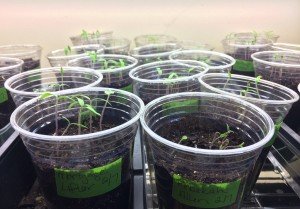
Starting My Garden Early
While Punxsutawney Phil and the meteorologists work out their differing predictions for the end of winter, growers are already hard at work preparing for spring, summer and fall.January plant starts included cabbage,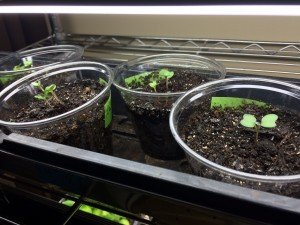 chili peppers, bell peppers and rosemary.
chili peppers, bell peppers and rosemary.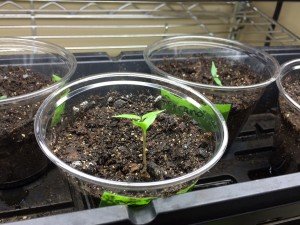 Now that February has begun, the seed starting kicks into high gear with oregano, collards and lots and lots of tomatoes with 8 varieties and a total of 38 plants this year!
Now that February has begun, the seed starting kicks into high gear with oregano, collards and lots and lots of tomatoes with 8 varieties and a total of 38 plants this year!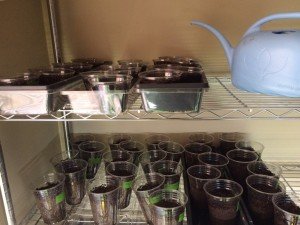 The new starts will welcome roommates in my growing nook for the cilantro and basil I grow indoors each winter. I purchased inexpensive shop lights, metal wire shelving units and florescent tubes 5 years ago so I never have to go a grey winter day without their bright colors and fresh flavors complimenting meals.
The new starts will welcome roommates in my growing nook for the cilantro and basil I grow indoors each winter. I purchased inexpensive shop lights, metal wire shelving units and florescent tubes 5 years ago so I never have to go a grey winter day without their bright colors and fresh flavors complimenting meals.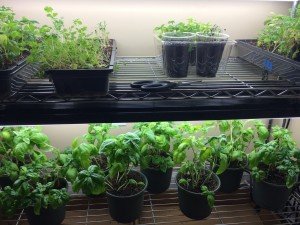 The minimal, initial investment for the equipment has more than paid for itself already and now as my garden diversifies and the number of indoor starts continue to expand each year with no additional infrastructure costs to date, I consider this money extremely well spent.Happy Spring, whenever it comes :)
The minimal, initial investment for the equipment has more than paid for itself already and now as my garden diversifies and the number of indoor starts continue to expand each year with no additional infrastructure costs to date, I consider this money extremely well spent.Happy Spring, whenever it comes :)
Fall Garden 2015
As I plan and finish planting my fall garden this weekend I have to give a shout out to the tomatoes, red bell peppers and serrano peppers that don't seem to care that it is the middle of September and are continuing to bloom and set fruit in earnest.Working around these summer hold-overs is a little easier with the addition this weekend of the last two 4-x-4 beds I had planned to add. I have also added 8 1-x-1 boxes that will be used for summer squash next year but are mostly available for planting now.I am trying a non-dwarf variety of collards this fall and trying parsnips for the first time.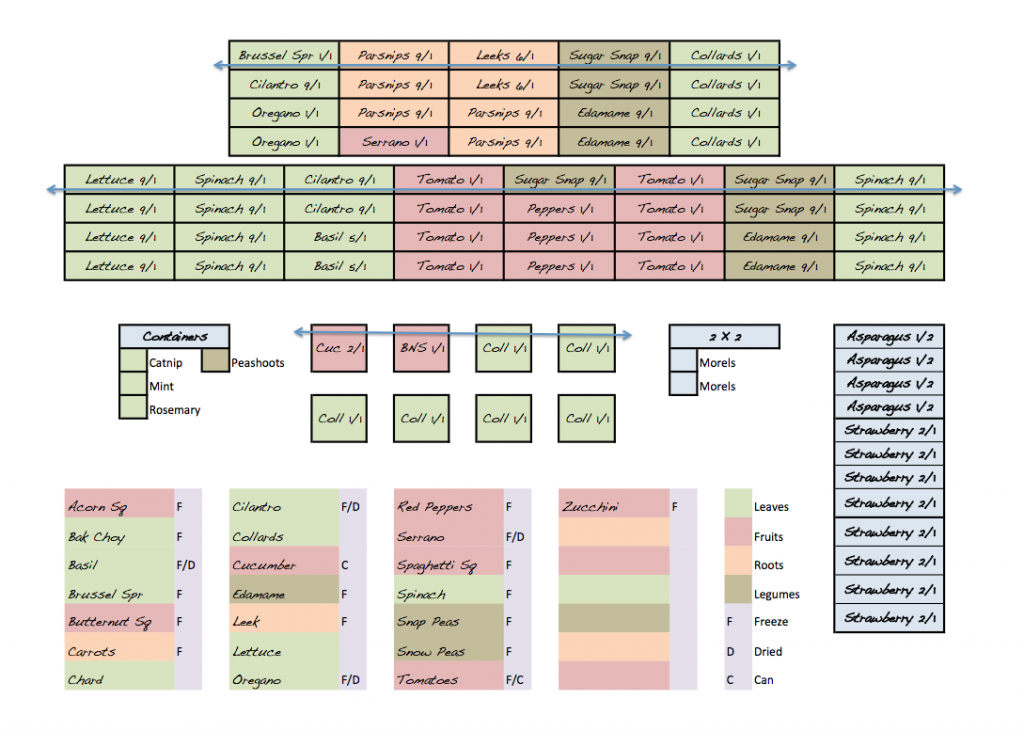 I have added permanent supports along the back portions of beds (blue lines on garden plan) by way of 6' metal fence stakes hung with rungs of coated wire to act as a ladder for climbing plants. It also works well as support for triangle shaped row covers.
I have added permanent supports along the back portions of beds (blue lines on garden plan) by way of 6' metal fence stakes hung with rungs of coated wire to act as a ladder for climbing plants. It also works well as support for triangle shaped row covers.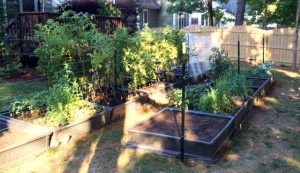 If all goes well I will be serving spinach at Christmas and collards on New Years all fresh from the garden!
If all goes well I will be serving spinach at Christmas and collards on New Years all fresh from the garden!



